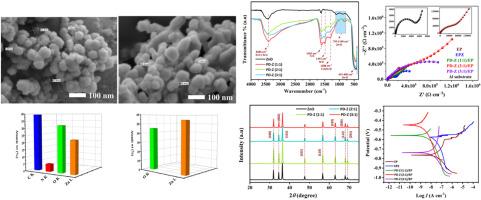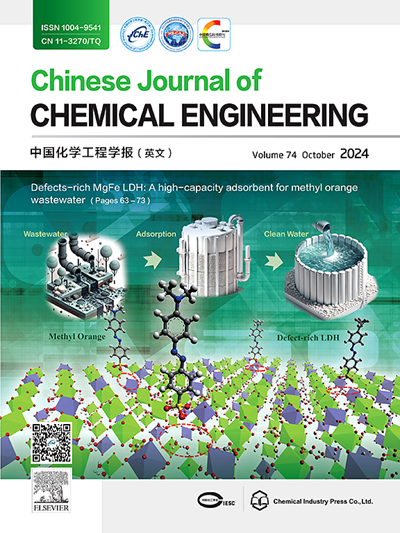多巴胺在氧化锌纳米颗粒上的自聚合增强环氧铝涂层的耐蚀性
IF 3.7
3区 工程技术
Q2 ENGINEERING, CHEMICAL
引用次数: 0
摘要
传统的有机涂层在腐蚀性环境中提供长期的防腐保护往往面临限制。本研究将一种双功能聚多巴胺-氧化锌(PD-Z)复合材料掺入环氧树脂(EP)基体(PD-Z/EP)中,以增强铝基材料的疏水性和耐腐蚀性。表征分析证实了PD-Z复合材料的成功制备。电化学测量,特别是动电位极化,在3.5%(质量)NaCl溶液中浸泡3天后进行,显著降低腐蚀电流密度(Icorr),从纯EP的249.4 nA·cm−2降低到PD-Z/EP的167 nA·cm−2。腐蚀速率由0.004降低到0.0002 mm·a−1。此外,电化学阻抗谱(EIS)显示,低频阻抗模量(|Z|0.01 Hz)从0.07 × 106增加到1.2114 × 106 Ω·cm2,表明具有良好的缓蚀作用。PD-Z/EP涂层优异的阳极和阴极保护性能是由于聚多巴胺和ZnO的协同作用,增强了氯离子的包裹,疏水屏障性能和整体耐腐蚀性。本文章由计算机程序翻译,如有差异,请以英文原文为准。

Self-polymerization of dopamine on zinc oxide nanoparticles for enhanced corrosion resistance in epoxy-aluminum coatings
Conventional organic coatings often face limitations in providing long-term corrosion protection in aggressive environments. This study introduces a dual-functional polydopamine-zinc oxide (PD-Z) composite incorporated into an epoxy (EP) matrix (PD-Z/EP) to enhance the hydrophobicity and corrosion resistance of aluminum substrates. Characterization analyses confirmed the successful fabrication of the PD-Z composite. Electrochemical measurements, specifically potentiodynamic polarization, are conducted after three days of immersion in a 3.5% (mass) NaCl solution, significantly decreasing corrosion current density (Icorr) from 249.4 nA·cm−2 for pure EP to 167 nA·cm−2 for PD-Z/EP. Concurrently, the corrosion rate decreased from 0.004 to 0.0002 mm·a−1. Additionally, electrochemical impedance spectroscopy (EIS) demonstrated a marked increase in the low-frequency impedance modulus (|Z|0.01 Hz) from 0.07 × 106 to 1.2114 × 106 Ω·cm2, indicating superior corrosion inhibition. The exceptional anodic and cathodic protective performance of the PD-Z/EP coating is attributed to the synergistic effects of polydopamine and ZnO, which enhance chloride ion entrapment, hydrophobic barrier properties, and overall corrosion resistance.
求助全文
通过发布文献求助,成功后即可免费获取论文全文。
去求助
来源期刊

Chinese Journal of Chemical Engineering
工程技术-工程:化工
CiteScore
6.60
自引率
5.30%
发文量
4309
审稿时长
31 days
期刊介绍:
The Chinese Journal of Chemical Engineering (Monthly, started in 1982) is the official journal of the Chemical Industry and Engineering Society of China and published by the Chemical Industry Press Co. Ltd. The aim of the journal is to develop the international exchange of scientific and technical information in the field of chemical engineering. It publishes original research papers that cover the major advancements and achievements in chemical engineering in China as well as some articles from overseas contributors.
The topics of journal include chemical engineering, chemical technology, biochemical engineering, energy and environmental engineering and other relevant fields. Papers are published on the basis of their relevance to theoretical research, practical application or potential uses in the industry as Research Papers, Communications, Reviews and Perspectives. Prominent domestic and overseas chemical experts and scholars have been invited to form an International Advisory Board and the Editorial Committee. It enjoys recognition among Chinese academia and industry as a reliable source of information of what is going on in chemical engineering research, both domestic and abroad.
 求助内容:
求助内容: 应助结果提醒方式:
应助结果提醒方式:


